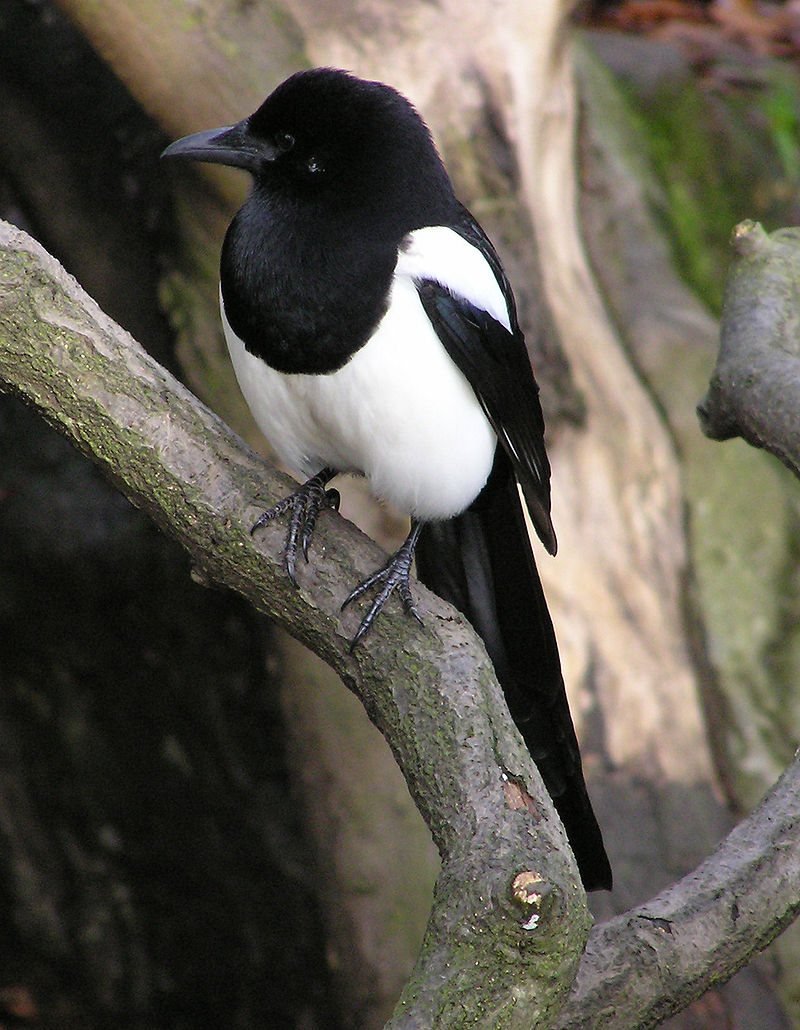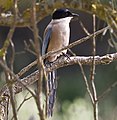- Genus Pica
- Eurasian magpie, Pica pica
- Black-billed magpie, Pica hudsonia (may be conspecific with P. pica)
- Yellow-billed magpie, Pica nuttalli (may be conspecific with P. (pica) hudsonia)
- Asir magpie, Pica asirensis (may be conspecific with P. pica)
- Maghreb magpie, Pica mauritanica (may be conspecific with P. pica)
- Korean magpie, Pica sericea (may be conspecific with P. pica)
- Genus Urocissa
- Taiwan blue magpie, Urocissa caerulea
- Red-billed blue magpie, Urocissa erythrorhyncha
- Yellow-billed blue magpie, Urocissa flavirostris
- White-winged magpie, Urocissa whiteheadi
- Sri Lanka blue magpie, Urocissa ornata
- Genus Cissa
- Common green magpie, Cissa chinensis
- Indochinese green magpie, Cissa hypoleuca
- Javan green magpie, Cissa thalassina
- Bornean green magpie, Cissa jefferyi
- Genus Cyanopica
- Azure-winged magpie, Cyanopica cyanus
- Iberian magpie, Cyanopica cooki
- The black magpie, Platysmurus leucopterus, is a treepie; it is neither a magpie nor, as was long believed, a jay. Treepies are a distinct group of corvids externally similar to magpies.
- The Australian magpie, Cracticus tibicen, is conspicuously “pied”, with black and white plumage reminiscent of a European magpie. It is a member of the family Artamidae and not a corvid.
Magpies are birds of the Corvidae (crow) family. The black and white Eurasian magpie is widely considered one of the most intelligent animals in the world[1][2][3] and one of only a few non-mammal species able to recognize itself in a mirror test.[4] In addition to other members of the genus Pica, corvids considered as magpies are in the genera Cissa, Urocissa and Cyanopica.
Magpies of the genus Pica are generally found in temperate
regions of Europe, Asia and western North America, with populations
also present in Tibet and high elevation areas of India, i.e. Ladakh
(Kargil and Leh) and Pakistan. Magpies of the genus Cyanopica
are found in East Asia and also the Iberian peninsula. The birds called
magpies in Australia are, however, not related to the magpies in the
rest of the world (see Australian magpie).
Systematics and species
According to some studies, magpies do not form the monophyletic group they are traditionally believed to be—a long tail has certainly elongated (or shortened) independently in multiple lineages of corvid birds.[5] Among the traditional magpies, there appear to be two distinct lineages. One consists of Holarctic species with black/white colouration and is probably closely related to crows and Eurasian jays. The other contains several species from South to East Asia with vivid colouration which is predominantly green or blue. The azure-winged magpie and the Iberian magpie, formerly thought to constitute a single species with a most peculiar distribution, have been shown to be two distinct species and classified as the genus Cyanopica.[6]Other research has cast doubt on the taxonomy of the Pica magpies, since it appears that P. hudsonia and P. nuttalli may not be different species, whereas the Korean race of P. pica is genetically very distinct from the other Eurasian (as well as the North American) forms. Either the North American, Korean, and remaining Eurasian forms are accepted as three or four separate species, or there exists only a single species, Pica pica.[7]
Holarctic (black-and-white) magpies
Other "magpies"
Cultural references
AsiaIn East Asian culture, the magpie is a very popular kind of bird. It is a symbol of good luck and good fortune.
The magpie is also a common subject in Chinese painting. It is also often found in traditional Chinese poetry and couplets. In addition, in the folklore of China, all the magpies of the Qixi Festival every year will fly to the Tianhe River, set up a bridge, and the separated Cowherd and Weaver Girl will meet, so that in Chinese culture, the bridge often becomes a relationship between men and women.
Magpies have an important place in the birth myth of Ai Xinjue Luo Bukuri Yushun, the ancestor of the Qing Dynasty.
The Korean magpie is a national bird and national symbol of Korea, sometimes referred to as the Asian magpie or Chinese magpie.
Pakistan
Also found widely in Northern Areas Of Pakistan specially in Baltistan. Common name in Baltistan is "Khaa-Strap".
Europe
In European culture, the magpie is reputed to collect shiny objects, often in fiction things like wedding rings or other valuable or significant objects (often causing consternation at the disappearance, and false accusation of humans in the plot of the story); the most well-known example probably being Rossini's opera "La Gazza Ladra" (The thieving magpie). Though recent research [8] has shown that there is little truth in the legend, and that magpies - like many animals - are actually unsettled by shiny, blue, or otherwise unusual objects.





No comments:
Post a Comment
Note: Only a member of this blog may post a comment.